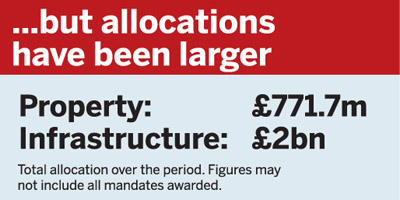Data analysis: Defined benefit and defined contribution schemes are once again circling infrastructure investments, but a lack of underlying assets and suitable funds – especially for DC investors – is holding back inflows.
The long-term, index-linked characteristics of the asset class have made it appealing for schemes looking to match their liabilities, but it has still lagged behind property in terms of the number of mandates awarded (see graph).

Devon County Council Pension Fund announced last week it has upped its investments to infrastructure and invested £40m in a liability-matching fund with Aviva Investors.
Assistant county treasurer Mark Gayler told Pensions Expert infrastructure provided a diversified form of return and an inflation link for the scheme.
“The Aviva investment has a direct link with inflation and so that provides an inflation-link to the investment, which is another risk which we face,” he said.
He said the fund will consider further investments in the asset class. “We have committed £90m to two different funds which will take us up to our [target] allocation. It will take a little while to get there because the money is only drawn down when new assets are purchased,” Gayler added.
However, there are concerns about the amount of infrastructure available for investment. “The infrastructure opportunities are not that great at the moment,” said Nita Tinn, director at Independent Trustee Services.
Infrastructure can also be a useful asset for DC due to its bond-like nature and regular returns, but few schemes have invested due to their requirement for daily pricing.
Infrastructure for DC
Many of the large DC providers have said they are considering the asset class, but have yet to make investments. Provider Scottish Life is considering infrastructure for its range of governed portfolios which can be used as default funds for group personal pension plans.
The infrastructure opportunities are not that great at the moment
Nita Tinn
Investment marketing manager Lorna Blyth said, “We have a watchful eye on infrastructure. It is fair to say it is an asset we are interested in but at the moment we are waiting to see what opportunities there are for us.”
Royal London Group, the owner of Scottish Life, is in talks with the National Association of Pension Funds about investing in the association’s Pensions Infrastructure Platform.
Nest is also actively researching infrastructure as an asset class and is also talking to groups including the NAPF.
“We hope to add infrastructure to our asset classes at some point, hopefully within the next 1-2 years, although as yet there are no solutions that can handle DC,” said chief investment officer Mark Fawcett. “However we know that providers are working on it.”
The lack of managers that provide DC-compliant infrastructure funds has been a major stumbling block for investment.
Darren Philp, head of policy at The People’s Pension, said: “[We] challenge the asset management industry to make it easier for DC schemes to invest in.”
The trustees will keep a close eye on new and innovative developments in the market, he added.
DC schemes are most likely to get exposure to infrastructure through diversified growth or blended funds.
“But unfortunately as a standalone investment it hasn’t been used in DC because of the daily dealings requirement,” said Tinn.
Joanna Sharples, DC investment principal at consultancy Aon Hewitt, said lack of liquidity is the main challenge for DC schemes when it comes to infrastructure investments.
“The industry needs to work on [infrastructure] to make it easier for DC,” said Sharples. “It may be necessary for the industry to be more accepting of solutions that don’t offer that daily liquidity because there is no real need for members to have it.”
She added there are a few managers starting to develop products that address the challenges.














